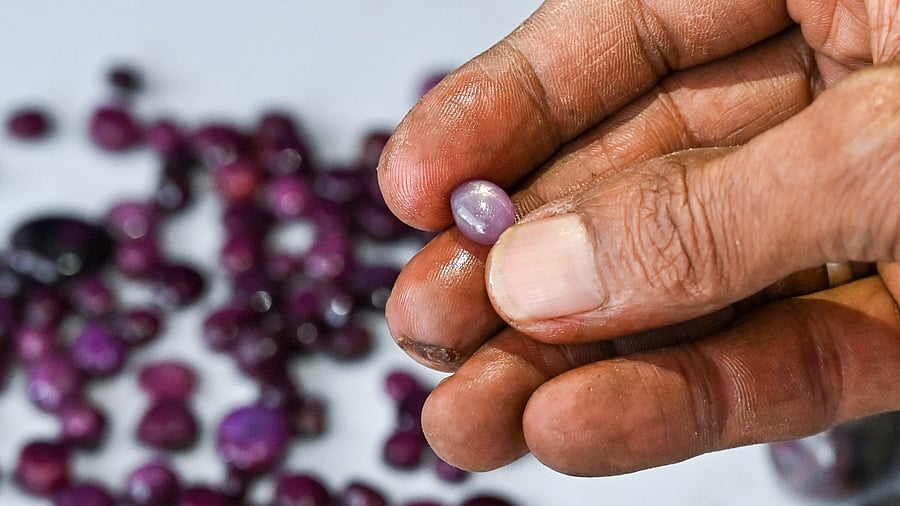
A gem store at Alipur, Chikkaballapur.
DH Photos by Pushkar V
When the first reports of missile strikes near Qom in Iran surfaced earlier this month, villagers in Alipur in Chikkaballapur district, paused, not in panic, but in prayer. For the close-knit Shia community in the village, about 70 km from Bengaluru, Iran is more than a distant country; it is a spiritual homeland, a cultural mirror, and a part of their extended identity.
“Alipur, often called ‘mini Iran’, is a unique Shia enclave where onion-domed mosques, the Imam Khomeini Road, and the Anjuman-e-Jafria Trust reflect generations of connection with Iran,” says Dr S Ahmed Abbas, an educationist and social worker based in Alipur.
The village’s religious and institutional life has long mirrored Shia heartlands, like Qom, shaping everything from education to architecture, he adds.
Today, the Anjuman-e-Jafria Trust, the Imam Khomeini Hospital (the foundation for which was laid by the current leader of Iran, Ayatollah Syed Ali Khamenei, when he visited Alipur in 1980), and the Behisht-e-Ali graveyard are pillars of the community. Dozens of Alipuris have studied and continue to enrol in Iranian seminaries, further strengthening theological and cultural ties. “These are more than symbolic connections,” says Dr Ahmed Abbas. “They shape the way we think, organise, and live.”
Going back in time
The Adil Shahi Sultanate, which ruled much of the Deccan from Bijapur, was a renowned centre of Shia scholarship, patronage, and Sufi culture. When Mughal emperor Aurangzeb captured Bijapur in 1686 AD, it marked not just the fall of a dynasty but the beginning of a broader religious and cultural shift. The Mughal regime, far less accommodating of Shia practices, led to the displacement of many Shia elites, scholars, and clergy who had once thrived under Adil Shahi patronage.
Renovation underway at the place of worship which is said to be 300-years-old in Alipur, Chikkaballapur.
Credit: DH Photo/Pushkar V
It was during this period of upheaval that Moulana Syed Mustafa Hussain, believed to be the earliest settler of Alipur, likely migrated from Bijapur in 1700 AD. Seeking a safer, more autonomous space to continue his religious and cultural traditions, he is thought to have journeyed southward into what was then a remote, forested settlement, explains Dr Ahmed Abbas. Under the stewardship of figures like Mustafa Hussain, the fledgling village evolved into a distinct Shia enclave.
From farmlands to fine rubies
Alipur is more than its history. Over the last 60 years, it has carved out a place on the world map as a gem-trading hub, with business links extending to Bangkok, Dubai, and even Iran. The economic story changed dramatically in the 1970s with the discovery of Corundum rubies nearby by a pioneer, named Mumtaz Hussain, a pioneer of gem discovery in the region, under whose guidance traders began trading gemstones, first locally and later with Jaipur.
By the 1980s, Alipuris were making their mark in Bangkok, launching family-run enterprises that now span the Gulf and Southeast Asia, says Syed Ibne Hassan, president of Alipur Gems & Jewellery Traders Association (AGJTA).
Gems at a store in Alipur, Chikkaballapur.
Credit: DH Photo/Pushkar V
Today, Alipur’s gem industry supports hundreds of families. Local lapidaries polish stones, and diaspora networks maintain trade routes and partnerships. The formation of the AGJTA in 2023 further formalised the trade, bringing a collective visibility, says Syed Ibne Hassan. “We have moved from the farm to the world stage, without losing our roots,” he adds.
Although mining over the years has depleted the resource and government regulations have been imposed, Raza Bakash, a gem trader in Alipur, believes that the quality, colour and hardness of the ruby, clear markers of a good gem, are far superior in Alipur.
Bakash adds that the rates of the rubies retail between Rs 2,500 to Rs 5,000 per carat for the Corundum ruby and Rs 5,000 and above per carat for a Star ruby.
A global tangle felt locally
While the Iran–Israel conflict has raised concerns across the world, in Alipur, the response here has been more measured than panicked. Fears of rising global fuel prices, temporary shipping delays, and cautious investment behaviour have all emerged as short-term challenges, but not insurmountable ones.
“We are used to adapting,” says Syed Ibne Hassan. “Markets shift. Borders change. We have seen slowdowns before, and we will get through this too.” Traders are maintaining a practical outlook, and there is no dramatic halt to the trade. Instead, there is quiet recalibration.
A few families have children studying in Qom or working in Iran. While the situation has prompted concern and a few precautionary returns, there is no widespread panic. India’s Operation Sindhu brought back students safely, and many families are staying in close touch with relatives abroad.
Mufarre, a final year MBBS student at the Tehran University, who returned to Alipur a couple of days ago, narrated the horrific and deafening sounds of missiles pounding outside her hostel in Iran. “Although the Israeli drones were intercepted, the bombing and the looming danger seemed impending. Moving to safer shelters in Qom and then Mashhad gave us hope, but now that we are back, we feel safe. We can only hope for a ceasefire and return to normalcy so that we can go back to complete our studies as Iran is also a very safe place for women,” she adds.
Alipur has always been more than a village; it is a living bridge between southern India and Shia West Asia, a place where identity travels across borders and business moves between faith and pragmatism, believes Mir Ali Abbas Ali, the president of Anjuman-e-Jafria.
As the Israel–Iran conflict continues to evolve, Alipur watches carefully but calmly. Its people, shaped by centuries of resilience and adaptation, are neither isolated nor overwhelmed.